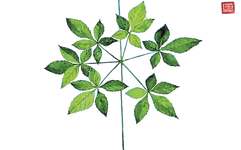
Ren Shen (Ginseng) (Part II)
Ginseng is excellent,
It nourishes the body’s vital essence.
It calms the spirit and generates fluids, enhancing strength,
Consuming it slowly builds vitality.
Who doesn’t love ginseng?
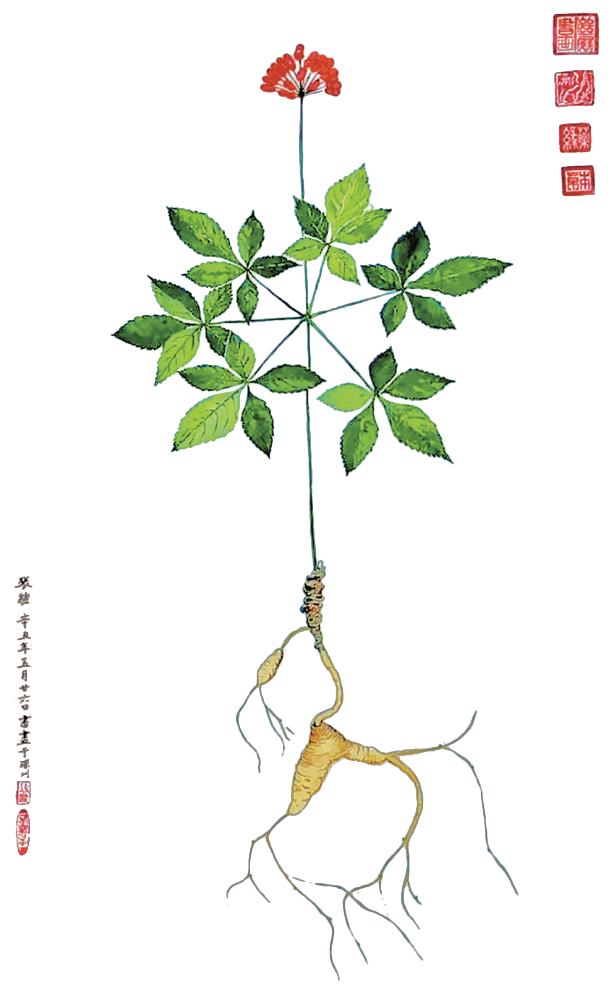



Distinguishing Quality and Authenticity

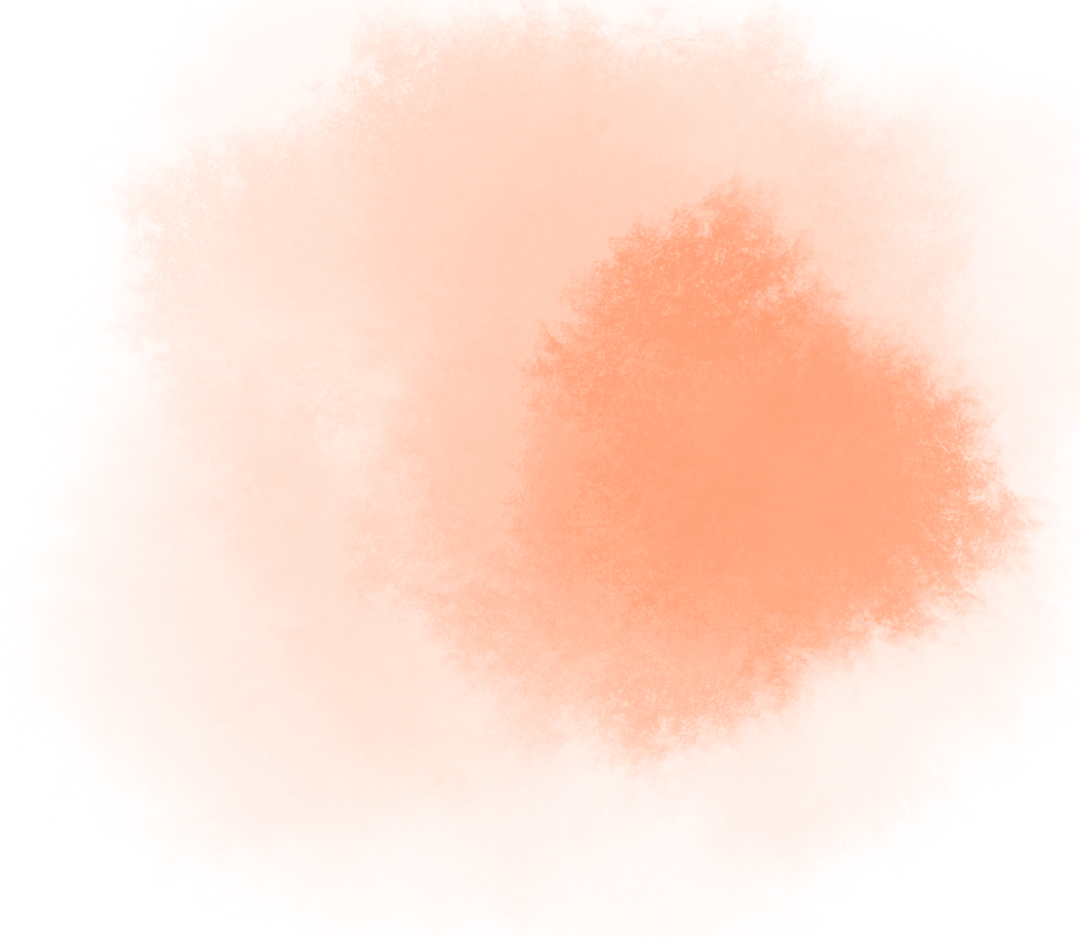

Diverse Ginseng Products
Freshly harvested ginseng has a thick, tender, and juicy texture, making it a unique tonic that can be used in soups or infused in liquor, providing a strong ginseng flavor. However, due to its high water content and active enzymes, fresh ginseng has a short shelf life, often spoiling within three to five days at room temperature, necessitating timely processing. Therefore, aside from its place of origin, fresh ginseng is rarely seen in the market. In recent years, with advancements in the pharmaceutical and food industries, various preservatives and biological regulation technologies have rapidly developed, extending the shelf life of fresh ginseng, making preserved ginseng products more commonly available in supermarkets.
The processing history of ginseng is long-standing. The “Shennong Bencao Jing” mentions processing methods such as “scraping with bamboo knives, drying in the sun, and avoiding exposure to wind.” The Song Dynasty’s “Xuanhe Fengshi Gaoli Tujing” records: “Koryo ginseng is classified into raw and cooked types; the raw type is white and weak, with full medicinal flavor, but is prone to pests in summer. The cooked type is more durable and can be stored.” This indicates that there was already a distinction between raw and cooked ginseng at that time.
In summary, the history of ginseng processing has evolved from drying fresh ginseng to boiling and drying, and further to steaming and drying. The effective components and their quantities vary with different processing methods, leading to differences in medicinal properties and effects. Currently, ginseng products on the market can be categorized based on processing methods into raw sun-dried ginseng, red ginseng, Koryo ginseng, sugar ginseng, and active ginseng.
Raw Sun-Dried Ginseng
Raw sun-dried ginseng is one of the mainstream products, processed simply by washing and drying fresh ginseng. This method does not expose the ginseng to high heat, preserving its natural components, particularly the effective ingredients like ginsenosides and volatile oils.
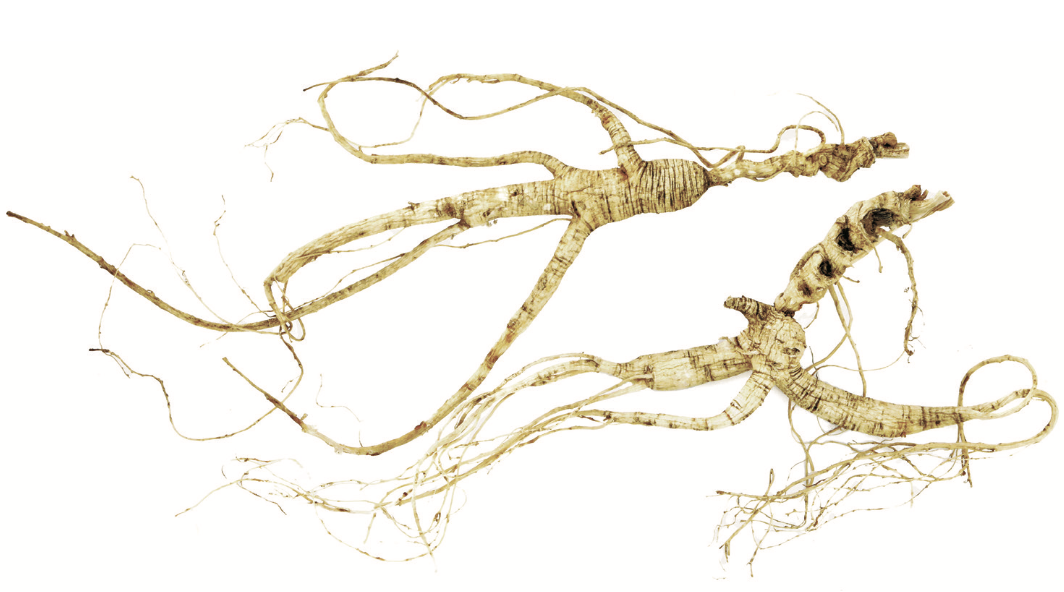
Gold Root Raw Sun-Dried Ginseng
Depending on whether the root hairs are retained during processing, it can be divided into whole root raw sun-dried ginseng and raw sun-dried ginseng. Whole root raw sun-dried ginseng retains all parts of the ginseng, including the root, stem, and hairs; while raw sun-dried ginseng often has the stem, root hairs, and some lateral roots removed. The other characteristics of both types are generally consistent, with a yellowish-white surface; the main root can vary in shape due to raw material differences, being cylindrical or spindle-shaped, light in weight, with longitudinal grooves, and some may show ring patterns in the upper middle part, with a hard texture; the cross-section is light yellow-white, powdery, with a distinct brown-yellow ring pattern, and the skin has numerous radial cracks, with visible yellow-brown resin ducts; it has a unique aroma and a sweet, slightly bitter taste.
Raw sun-dried ginseng is similar in properties to fresh ginseng, with a milder warming effect, primarily tonifying Qi, suitable for those with Qi deficiency. It can be taken regularly, infused in liquor, or powdered for consumption.
Red Ginseng
Red ginseng is also one of the mainstream products, made by first steaming fresh ginseng at high temperatures, causing changes in its sugar content, and then drying it. Some may also have the root hairs trimmed and pressed into shape. After processing, the ginseng appears reddish-brown or brown-red, hence the name “red ginseng.”
After steaming, the starch in ginseng transforms into red dextrin due to the high temperature, changing its color to red, and after drying, the texture becomes hard. Additionally, various components undergo complex chemical changes during steaming and roasting, leading to the hydrolysis of heat-sensitive ginsenosides, forming new unique ginsenosides and polyacetylene compounds, which alters the biological activity of ginseng.
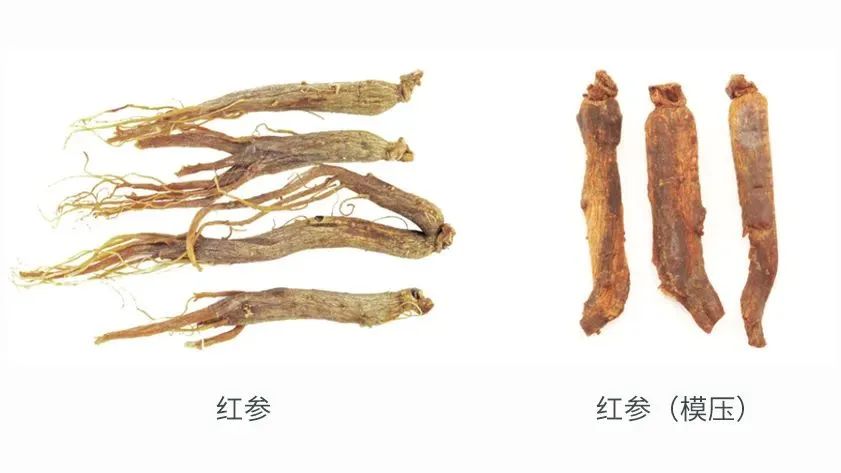
In terms of appearance, red ginseng is reddish-brown and semi-transparent; some main roots may have opaque dark yellow spots, resembling a yellow coat, commonly referred to as “yellow coat” or “ginger skin”; it is hard and brittle, easily broken; the cross-section is flat, with a glossy appearance and slight radial texture; it has a faint and unique aroma, with a sweet, slightly bitter taste. Traditionally, red ginseng is considered superior if it is long, thick, red, without yellow skin, cracks, or breaks, and has a solid body with a strong aroma.
Compared to raw sun-dried ginseng, red ginseng has a warmer nature, characterized by its strong warming and tonifying effects, making it particularly effective for treating deficiency syndromes, suitable for elderly patients with chronic illnesses. However, due to its strong warming properties, adverse reactions can be pronounced if misused, so caution is advised when using it.
Sugar Ginseng
Sugar ginseng, also known as white sugar ginseng, is typically made by washing and drying fresh ginseng, then pricking it with needles to create small holes, and soaking it in a pot of boiling rock candy syrup, allowing it to absorb the syrup and expand fully before cooling and dehydrating. The tender, plump, and pure white ginseng is coated with a white crystalline substance, making it appear even cleaner.
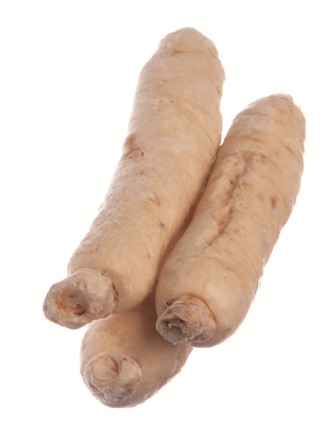
Sugar Ginseng
Under the influence of sugar, ginseng can alter its inherent taste, making it easier to consume. Due to its pleasant taste and convenience, sugar ginseng is often used as a daily tonic. It is generally not included in prescriptions, but is consumed for mild conditions such as enhancing children’s intelligence or treating bedwetting, or for relieving fatigue and hangovers.
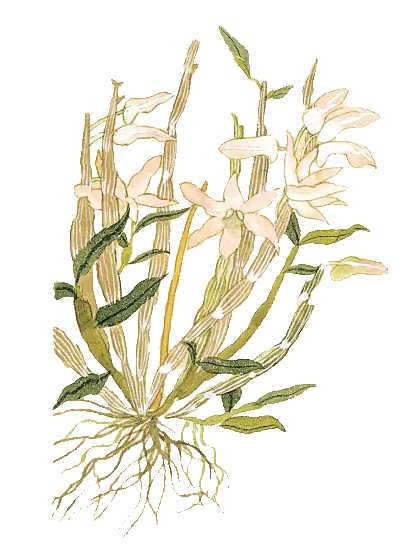
Distinguishing Quality to Avoid Deception
Ginseng’s efficacy varies based on factors such as origin, cultivation methods, and processing techniques. When purchasing ginseng, it is essential to consider personal health needs and consult with a professional pharmacist to select the appropriate type.
However, in daily life, ginseng purchased from pharmacies is often sliced, making it necessary to distinguish the quality and authenticity of various ginseng slices. The most commonly used ginseng slices in hospitals and pharmacies are raw sun-dried ginseng slices and red ginseng slices.
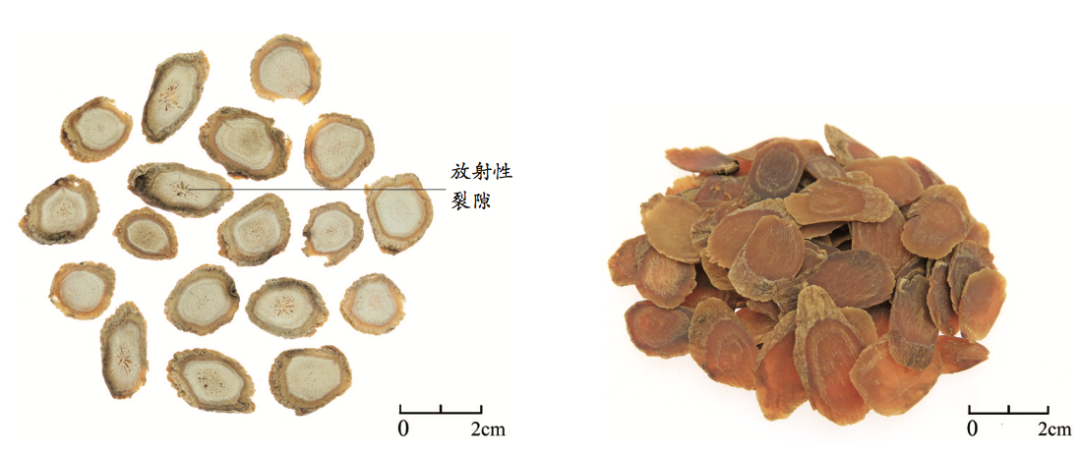
Raw Sun-Dried Ginseng Slices Red Ginseng Slices
Raw sun-dried ginseng slices are round or oval thin slices; the outer skin is grayish-yellow, and the cross-section is light yellow-white or whitish, showing a powdery texture with brown-yellow ring patterns, and the skin has yellow-brown resin ducts and radial cracks; they are light and brittle; with a unique aroma and a sweet, slightly bitter taste.
Red ginseng slices are mostly long oval or round thin slices, with a reddish-brown outer skin and longitudinal wrinkles; the cross-section is flat, with ring patterns and small resin ducts that are not prominent, dense without cracks, glossy, semi-transparent, with a light-colored center; they are hard and brittle; with a faint and unique aroma, and a sweet, slightly bitter taste.
Ginseng is expensive and can spoil easily if not stored properly, so purchasing good quality ginseng requires careful storage. The best method for home storage is sealing; ginseng can be separated from food-grade desiccants and placed in a sealed storage container, kept in a cool, dry place.
Some prefer to store ginseng directly in the refrigerator for convenience, but due to the mixing of various foods, ginseng can easily absorb moisture and odors, leading to mold or discoloration over time. Therefore, it is advisable to first place ginseng in a small sealed container before storing it in the refrigerator.



Tasting the Flavors of Life


Greatly Nourishing Vital Energy and Dual Regulation
Traditional Chinese Medicine believes that ginseng can greatly nourish vital energy and rectify deficiency syndromes. Ginseng can also enhance the body’s immune function, supporting the righteous and expelling the evil.
Interestingly, ginseng has a dual regulatory effect; it can help the body transition from a state of low function to normal, and also help the body return to normal from a state of over-excitement. Proper use of ginseng can lead to a feeling of mental clarity during the day and deep sleep at night. Ginseng also has a notable dual effect on blood sugar regulation; when feeling excessively hungry and experiencing cold limbs or dizziness, chewing ginseng can help raise blood sugar levels; for diabetic patients, adding ginseng often yields remarkable results when other treatments have failed.
Moreover, modern research indicates that ginseng influences cardiovascular health, promotes appetite and protein synthesis, mimics sex hormones, stimulates hematopoiesis, delays aging, combats osteoporosis, and has anti-tumor effects, significantly enhancing the endurance of mental activities, increasing intensity and prolonging duration.

Correct Usage and Avoiding Misuse
Traditional Chinese Medicine often states, “When external pathogens are not cleared, avoid pure tonics,” as this can easily lead to “misusing tonics to exacerbate illness.”
Patients with excess conditions caused by external pathogens, such as colds, fevers, or sores, have significantly different metabolic conditions compared to healthy individuals, and taking ginseng may worsen their condition. Additionally, even small amounts of ginseng can raise blood pressure, so patients with nephritis or hypertension should use ginseng cautiously.
Newborns have weak constitutions, and their organs are very delicate, making ginseng products unsuitable for them. Children with weak constitutions or developmental delays should use ginseng under medical guidance, and healthy adolescents should avoid ginseng to prevent issues like precocious puberty.
Furthermore, certain foods should not be consumed simultaneously with ginseng. Strong tea, mung beans, plums, grapes, pomegranates, hawthorn, and persimmons contain tannins that can reduce ginseng’s efficacy. Radishes and radish seeds can also affect ginseng’s Qi-tonifying properties and should not be eaten with ginseng.
Ginseng has a wide range of applications, and its usage and dosage should be determined based on the intended purpose and specific circumstances, following medical advice. Common methods of consumption include:
01
Chewing
Also known as sucking. Cut ginseng into thin slices and place them in the mouth, gently chewing as if chewing candy, using saliva to dissolve the effective components before swallowing. This method is simple and convenient, and ginseng slices can be carried for on-the-go consumption. The daily total amount is 2 to 3g, taken in multiple doses. It is best to rinse the mouth before use to minimize bacterial residue.
02
Powdering
Dry the ginseng slices and grind them into fine powder, either as a powder or filled into empty capsules. This method reduces the direct stimulation from ginseng’s taste in the mouth, typically taken in doses of 1 to 3g daily, divided into 3 to 4 doses.
03
Infusion
Place ginseng slices in a cup, pour in boiling water, and steep for several minutes before drinking, replenishing water as needed. In the evening, the ginseng can be chewed and swallowed. This method is both simple and practical, with a daily amount of 1 to 3g, and avoid using metal containers.
04
Decoction
Add ginseng slices to water, place in a ceramic pot, and simmer several times, combining the decoction for consumption or taking it with other herbal decoctions. This method allows the effective components of ginseng to dissolve rapidly in water, with a higher concentration for quick absorption and noticeable effects, but the temperature fluctuations during decoction can significantly affect the effective components, requiring a larger amount.
05
Infusion in Alcohol
Soak ginseng slices in high-quality white liquor, seal tightly, and store in a cool place, shaking once daily. After 15 to 20 days, it can be opened for consumption, typically taken twice daily, 15 to 20ml each time. This method is easily absorbed by the body and is one of the commonly used methods for raw sun-dried ginseng.
06
Medicinal Cuisine
Ginseng Chicken Soup
Ingredients: 15g ginseng, 1 hen, appropriate seasonings.
Method: Cut the chicken into pieces, place in a clay pot, add ginseng and water, and steam for 1.5 hours. When the chicken is about 80% cooked, add appropriate amounts of green onion, ginger, salt, yellow wine, and pepper to season, and continue cooking until the chicken is tender.
Effects: Tonifies the middle and benefits Qi, nourishes the heart and calms the spirit.
Application: Suitable for various conditions of fatigue, Qi deficiency, blood deficiency, physical weakness, forgetfulness, palpitations, and insomnia. Consume one small bowl at a time, eating the meat and drinking the soup, for 3 to 5 days. (See “Dictionary of Chinese Medicinal Cuisine”)
Ginseng and Goji Berry Porridge
Ingredients: 15g ginseng, 20g goji berries, 150g rice.
Method: Place ginseng, goji berries, and rice in a pot, add 800ml of water, bring to a boil over high heat, then simmer for 35 minutes.
Effects: Nourishes the liver and kidneys, brightens the eyes.
Application: Suitable for conditions of liver and kidney deficiency, true Yang deficiency, insufficient Qi, cold extremities, spontaneous sweating, impotence, and high cholesterol. Consume for breakfast or dinner. (See “Nutrition Recipes for Hyperlipidemia and Obesity”)
Steamed Ginseng with Soft-Shelled Turtle
Ingredients: 10g ginseng, 10 red dates, 9g Ophiopogon, 10g Salvia miltiorrhiza, 1 soft-shelled turtle, 10g green onion, 10ml cooking wine, 10ml soy sauce, 3g salt, 5g ginger, 300ml chicken broth.
Method: Clean the turtle, remove the head and claws, and gut it. Place ginseng, red dates, Ophiopogon, and Salvia miltiorrhiza on the turtle, season with cooking wine, soy sauce, and salt, cover with the turtle shell, add ginger, green onion, and chicken broth. Place the turtle in a steamer and steam for 35 minutes over high heat.
Effects: Nourishes Yin, tonifies the kidneys, and replenishes Qi and blood.
Application: Suitable for patients with kidney Yin deficiency. (See “Cardiac Disease Medicinal Cuisine”)

END
Source: National Pharmacopoeia Commission (This article is published by the “Kaifeng Food and Drug Quality Safety Center” WeChat public account for the purpose of disseminating more information. If there are any errors in source attribution or infringement of your legal rights, please contact us promptly, and we will correct, delete, or handle it according to the law.)
<img src=”https://mmbiz.qpic.cn/mmbiz_jpg/2tR391WhbUP6nLfCKyPCUJsdWvGfWq9iagHL7gjbUsd4zOF2uR8aD4tfgTLlwLgnb4Ib432Zl1PiaPWIzU3nChXg/640?wx_fmt=jpeg”

